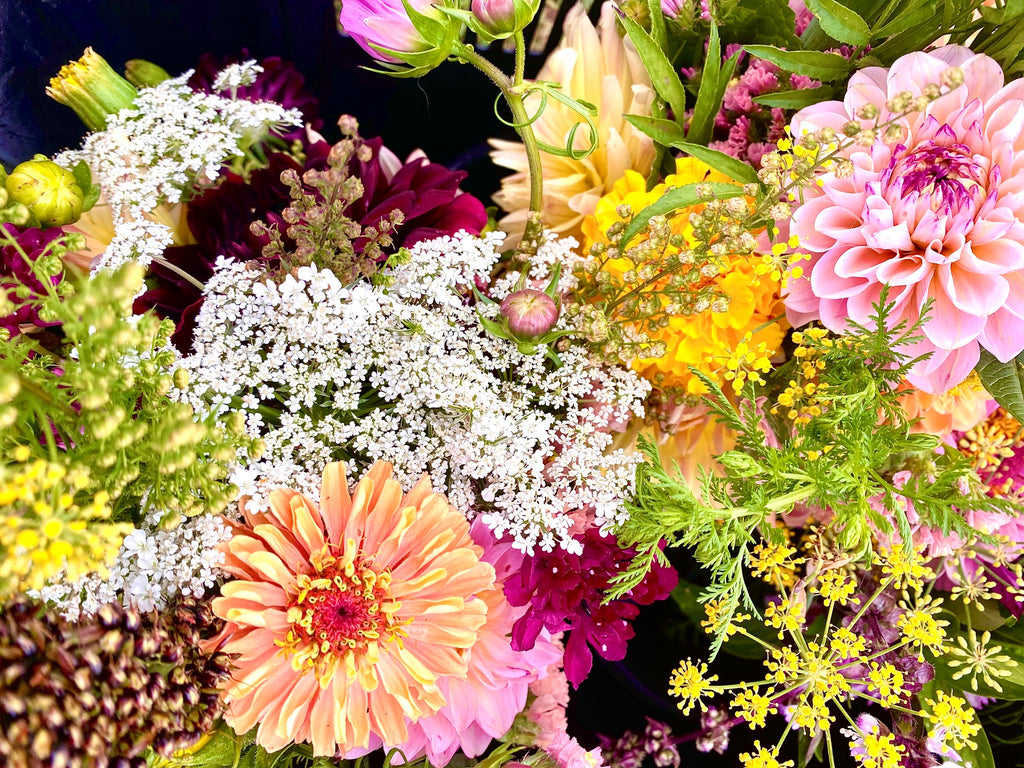- Choose the right varieties. The cut flower industry is vast and there has been a lot of development in cut flower specific varieties over the years. Choosing varieties that have been bred and selected for cut flower production can go a long way towards creating lasting bouquets. In variety descriptions look for phrases like “long vase life”, “strong stems”, or “bred for cut flowers”. Although, every flower is beautiful and worth growing, not all flower types or varieties are optimal for floral arrangements.
- Plan for the future. If you are a regular to our blog you know we love perennial plants. Not only do they keep the soil covered and create habitat for pollinators, but they also have beautiful flowers. Planting perennials can lower seed costs each year because you do not have to buy new seed or plants each year. Flowers like echinacea, lavender and columbine make excellent additions to your flower garden but they do not bloom the first year that you plant them. If you want to incorporate perennials in your garden and have years of blooms ahead of you then now is a great time to get started.

- Expand your bloom window. Although it is nice to have tons of flowers in August, there are lots of varieties that bloom in the spring and into the fall. When you pick varieties for your garden choose flowers that are hardy during the shoulder seasons and that have early or late bloom windows. This will have your garden beautiful and blooming for a longer period of time. Poppies, Bells of Ireland, Calendula, and Cerinthe are a few early flowers to consider. Planting seeds in the late summer and early fall can also help expedite the bloom window for those plants. Sweet peas, larkspur and foxglove are examples of seeds you can start in late summer to give them a jump start on bloom time the following year.
- Don’t forget your fillers. The first year I seriously grew flowers, I forgot to plant any filler varieties. Fillers are light, airy plants that add texture and volume to your bouquets. These can be herbs, plants grown just for the greens or varieties with small delicate flowers. Some of my favorite fillers to use are dill, basil, grains and sweet peas.
- Plant in successions. If you want to have certain flowers throughout the growing season it is important to plant them in succession. Some flowers are one and done, meaning they only can be harvested once. If you want to enjoy these varieties for longer, seed them every 2-3 weeks until about 8-10 weeks before your last frost date depending on the flower variety.
- Space your flowers properly. Flowers have different growth habits and the way you choose to space them in the garden will impact how they grow. If they are cut and come again varieties like zinnia you can give them more room. If they are one and done like Argostemma or non branching sunflowers you should plant them closer together to optimize space. Planting things closer together will also keep the plants from growing too large making them a better size for bouquets. Amaranth is a great example of a flower that should be planted close together.
- Use a trellis. Not all flowers require support to grow tall and strong. However, some flowers benefit from horizontal trellis netting. A trellis will help support the plant and growth of straight stems. Other ways to support plants is a central stake that holds up the main stem. I find this most useful with cosmos and dahlias.

- Pinch your seedlings. Just like the last tip, not every flower benefits from this. Pinching is when you snip off the top of a plant above a growth node when it is between 6-8 inches tall. This promotes lateral branching off the stem and will lead to more blooms on the plant. Snapdragons, zinnias, and asters all benefit from pinching.
- Water well. For vigorous plants make sure to water the appropriate amount. We want big juicy flowers and this takes water. I also recommend using drip tape or soaker hoses. Overhead water can lead to damaged petals and disease like downy mildew. If you want to conserve water in your garden, use mulch to insulate the soil and prevent undo water evaporation.
- Keep cutting! Most flowers with exception of those who have one single bloom benefit from continuous harvest. Plants are basically always trying to make seeds. If you cut off a flower the plant will make a new flower to keep moving towards this ultimate goal. The more you harvest from your garden the more it will keep growing new blooms. Sometimes the secondary or subsequent blooms will not be quite as large as the first initial flower.
I hope you enjoy growing flowers this year too! Having flowers in my home and garden provide me with endless joy and beauty throughout the year. If you want some more tips for spacing check out our Flower Planting Guide. If you want are looking for a comprehensive germination chart, check out our Germination Charts. A lot of our variety description on the website have growing tips as well.
Happy Planting!
-Taryn Hunter


Linda
I’m trying to start a flower garden but I haven’t a clue where to start. Is there a book or you tube you could recommend. Thank you